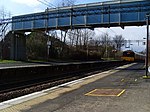Drumchapel St Andrew's Church
1940 establishments in ScotlandCategory C listed buildings in GlasgowChurch of Scotland churches in GlasgowChurches completed in 1940Drumchapel ... and 1 more
Listed churches in Glasgow

Drumchapel St Andrew's Church is a 20th-century parish church of the Church of Scotland located in the Old Drumchapel area of Glasgow. The church is sometimes referred to as the "White Church" due to its white painted walls.
Excerpt from the Wikipedia article Drumchapel St Andrew's Church (License: CC BY-SA 3.0, Authors, Images).Drumchapel St Andrew's Church
Garscadden Road, Glasgow Old Drumchapel
Geographical coordinates (GPS) Address Phone number Nearby Places Show on map
Geographical coordinates (GPS)
| Latitude | Longitude |
|---|---|
| N 55.906461 ° | E -4.364817 ° |
Address
Little Fishes Nursery
Garscadden Road 153
G15 6UQ Glasgow, Old Drumchapel
Scotland, United Kingdom
Open on Google Maps









